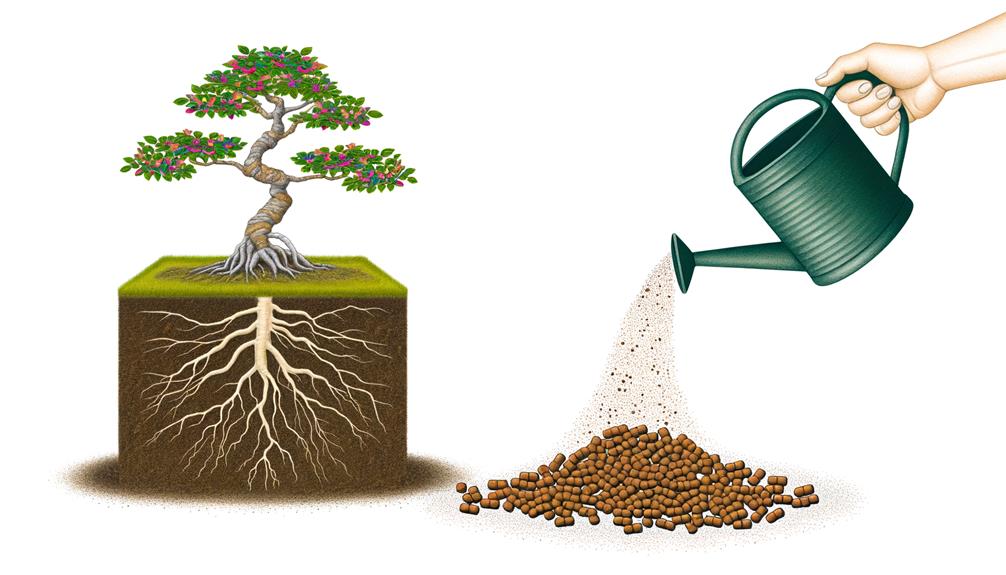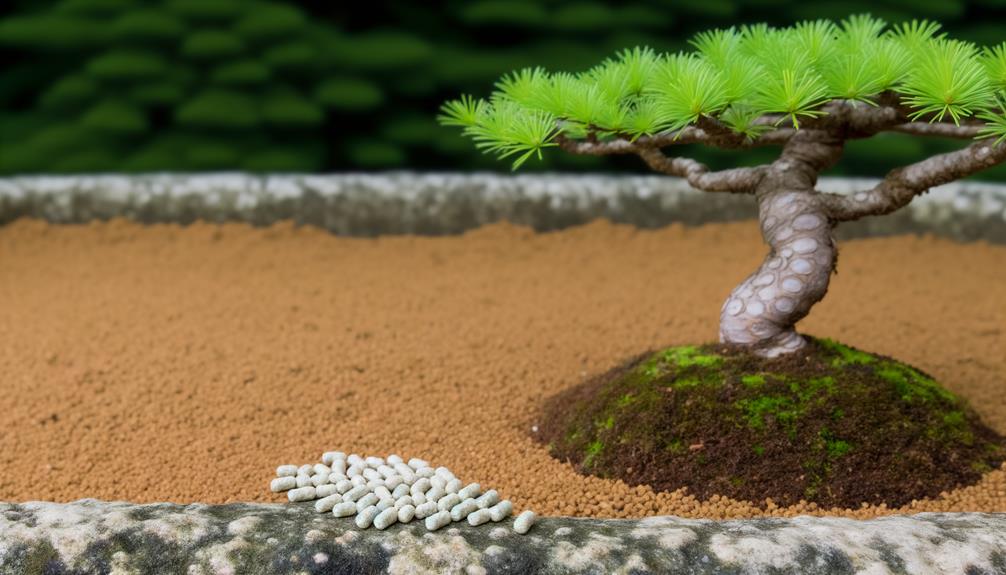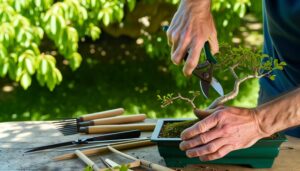10 Essential Steps to Use Biogold Bonsai Fertilizer
To use Biogold Bonsai Fertilizer, begin by applying pellets during the active growing season (spring to autumn) at intervals of 4-6 weeks. Position the pellets 1-2 inches from the trunk and distribute them evenly for balanced nutrient dispersion.
Pre-moisten the soil before application. For a 4-inch pot, apply 2-4 pellets, increasing the number proportionately for larger bonsai.
Avoid fertilization during dormancy. Monitor plant response by checking leaf color, root development, and growth rate, adjusting as necessary.
Continue below to master the thorough care techniques for best bonsai health and growth.

Key Takeaways
- Apply Biogold during the active growing season, from early spring to late autumn.
- Place pellets 1-2 inches away from the trunk, avoiding direct contact with trunk or foliage.
- Use 2-4 pellets per 4-inch pot diameter, increasing for larger bonsai.
- Replenish pellets every 4-6 weeks and monitor plant response for adjustments.
- Cease fertilization during dormancy periods and resume in early spring.
Understanding Biogold Fertilizer

Biogold fertilizer is an organic, slow-release nutrient source specifically formulated to meet the unique nutritional needs of bonsai trees. It contains a balanced ratio of essential macronutrients—nitrogen (N), phosphorus (P), and potassium (K)—ensuring best growth and development.
Additionally, Biogold is enriched with trace elements such as iron (Fe), manganese (Mn), and zinc (Zn), which are vital for maintaining plant health and vigor. The fertilizer's granulated form promotes gradual nutrient availability, preventing nutrient leaching and minimizing the risk of over-fertilization.
Biogold's organic composition enhances soil structure and microbial activity, which improves nutrient uptake efficiency. To apply, uniformly distribute the granules on the soil surface, avoiding direct contact with the trunk, and water thoroughly to activate nutrient release.
Benefits of Biogold
One of the primary benefits of Biogold fertilizer is its ability to provide a balanced and consistent supply of essential nutrients, which are important for the best growth and health of bonsai trees.
This slow-release fertilizer guarantees a steady availability of macronutrients such as nitrogen (N), phosphorus (P), and potassium (K), as well as trace elements like iron (Fe), manganese (Mn), and zinc (Zn).
The microbial activity induced by Biogold enhances nutrient uptake efficiency, promoting robust root development and vibrant foliage.
Additionally, Biogold's organic composition minimizes the risk of chemical burns and soil contamination, fostering a sustainable growing environment.
The inclusion of humic acids further improves soil structure, water retention, and cation exchange capacity, ensuring vital conditions for bonsai vitality.
When to Apply

To maximize nutrient uptake and plant health, it is crucial to apply Biogold bonsai fertilizer during the active growing season, typically from early spring to late autumn. During this period, bonsai trees exhibit vigorous growth, facilitating ideal absorption of essential macro- and micronutrients.
Apply the fertilizer at intervals of 4-6 weeks, ensuring the soil remains consistently moist but not waterlogged. Monitor ambient temperatures and adjust application frequency accordingly; higher temperatures may require more frequent applications.
Avoid fertilizing during periods of dormancy, as the plant's metabolic processes are markedly reduced, leading to potential nutrient buildup and root damage.
Regularly inspect for signs of over-fertilization, such as leaf burn or nutrient lockout, to maintain a balanced and healthy bonsai ecosystem.
Preparing Your Bonsai
Before applying Biogold bonsai fertilizer, it is essential to evaluate the tree's overall health and structural integrity to guarantee ideal nutrient absorption and growth.
Begin by inspecting the root system, confirming it is free from rot and pests, and that the roots are well-established and healthy. Prune dead or diseased branches to encourage vigorous growth.
Check the foliage for signs of nutrient deficiencies, such as chlorosis or necrosis, which may indicate underlying issues. Make sure the soil pH is within the best range (5.5-6.5) for nutrient uptake.
Sufficient watering before fertilization is necessary; the soil should be moist but not waterlogged. Finally, ensure the bonsai is in a stable position to prevent any physical stress during fertilization.
Placement of Biogold

Placing Biogold bonsai fertilizer correctly on the soil surface is essential to achieve peak nutrient distribution and efficient uptake by the root system. To achieve the best application, follow these steps:
- Strategic Positioning:
Place the Biogold pellets evenly around the base of the bonsai tree, making sure they are spread uniformly across the soil surface. This promotes balanced nutrient dispersion.
- Proximity to Root Zone:
Position the pellets approximately 1-2 inches away from the trunk. This placement encourages the roots to grow outward in search of nutrients, enhancing overall root health and stability.
- Avoiding Direct Contact:
Ensure the pellets do not directly touch the trunk or foliage to prevent potential chemical burns or nutrient overload, which can harm the bonsai.
Amount to Use
Determining the appropriate quantity of Biogold bonsai fertilizer is critical to guaranteeing ideal nutrient levels without risking over-fertilization. For best results, apply 2-4 pellets per 4-inch pot diameter. This dosage guarantees a balanced nutrient supply, facilitating robust root development and foliage growth.
For larger bonsai, incrementally increase the number of pellets proportionately, maintaining consistency with the pot size. Monitor the plant's response closely, adjusting the amount if any signs of nutrient imbalance, such as chlorosis or stunted growth, appear.
It is recommended to replenish the fertilizer every two months during the growing season, ensuring sustained nutrient availability. Adhering to these guidelines will enhance the overall health and importance of your bonsai.
Watering After Application

Ensuring proper watering after the application of Biogold bonsai fertilizer is essential to facilitate nutrient absorption and prevent root burn. Adequate hydration helps dissolve the nutrients, allowing for efficient uptake by the plant roots.
Follow these steps to achieve effective watering:
- Initial Light Watering: Apply a moderate amount of water immediately after fertilization to initiate nutrient dissolution without saturating the soil.
- Consistent Moisture Maintenance: Regularly monitor soil moisture levels to maintain a consistent, slightly damp environment, avoiding both waterlogging and dehydration.
- Water Quality: Use dechlorinated or rainwater to prevent chemical interference with nutrient absorption, thereby promoting healthy root development.
Frequency of Use
Determining the best application schedule for Biogold Bonsai Fertilizer is essential for maintaining plant health and growth.
Seasonal usage guidelines should be adhered to, ensuring adjustments are made for varying climatic conditions.
Monitoring plant response through careful observation and periodic assessment will help in fine-tuning the frequency of fertilizer application.
Optimal Application Schedule
The best application schedule for Biogold Bonsai Fertilizer involves applying the product every four to six weeks during the active growing season, which typically spans from early spring to late fall. This frequency supports peak nutrient uptake and sustained growth. Adhering to this schedule guarantees that the bonsai receives a consistent supply of essential macronutrients and micronutrients.
To enhance the application:
- Monitor soil moisture: Check that the soil is neither excessively dry nor waterlogged before application.
- Uniform distribution: Evenly scatter the fertilizer around the root zone to promote balanced nutrient absorption.
- Post-application watering: Gently water the soil post-application to facilitate nutrient dissolution and absorption.
Seasonal Usage Guidelines
Adapting the frequency of Biogold Bonsai Fertilizer application to the specific seasons is crucial for optimizing nutrient availability and promoting healthy bonsai growth. During the active growing season, typically spring and summer, apply Biogold every 4-6 weeks to support vigorous growth and development.
In autumn, reduce the application frequency to every 6-8 weeks to prepare the bonsai for dormancy. During winter, when growth slows, limit fertilizer application to once every 8-10 weeks to avoid nutrient overload.
Always consider the specific requirements of your bonsai species, as different species may have unique nutritional needs throughout the year. This seasonal adjustment guarantees that the bonsai receives appropriate nutrients at each growth stage, enhancing overall strength and resilience.
Monitoring Plant Response
Consistently monitoring your bonsai's physiological responses to Biogold Bonsai Fertilizer applications is essential for fine-tuning the frequency of use to achieve peak nutrient absorption and plant health. Observing the plant's phenological stages and physiological markers will enable precise adjustments.
Key indicators to monitor include:
- Leaf Color and Vigor: Assess chlorophyll content and leaf turgidity to evaluate nutrient uptake efficiency.
- Root Development: Examine root health and growth patterns, making sure the fertilizer does not cause root burn or stagnation.
- Growth Rate and Morphology: Monitor internodal length and overall canopy development to guarantee balanced growth.
Seasonal Adjustments

Seasonal adjustments in the application of Biogold Bonsai Fertilizer are vital for optimizing bonsai health and growth.
During spring, it is recommended to begin fertilization as new growth appears, ensuring the nutrient supply aligns with the tree's active growth phase.
Conversely, in winter, reduce or cease fertilization to account for the plant's dormancy period, thereby preventing nutrient overload and potential root damage.
Spring Application Timing
During the early stages of spring, the application of Biogold Bonsai Fertilizer should commence once the buds begin to swell, signaling active growth and nutrient uptake. This is a critical period wherein the bonsai's metabolic processes accelerate, necessitating prime nutritional support.
For effective application, follow these guidelines:
- Frequency: Administer Biogold Bonsai Fertilizer every 4 to 6 weeks throughout the spring season to maintain consistent nutrient availability.
- Dosage: Apply at a rate of 5 grams per square foot of soil surface, evenly distributed to prevent nutrient imbalances.
- Watering: Guarantee the soil is adequately moistened before and after fertilizer application to facilitate nutrient absorption and minimize root burn.
Adhering to these practices will support robust bonsai development during the spring.
Winter Dormancy Considerations
As winter dormancy approaches, it is crucial to adjust the fertilization routine to accommodate the bonsai's reduced metabolic activity. During this period, the physiological processes of the bonsai slow significantly, necessitating a decrease in nutrient supply.
Cease Biogold fertilization approximately four to six weeks before the onset of the dormancy phase to prevent nutrient accumulation that could cause root burn or unwanted growth. Make sure soil moisture levels are maintained, but avoid waterlogging, which can worsen root rot.
Additionally, monitor ambient temperatures and humidity to provide prime dormancy conditions. Resume Biogold application gradually in early spring as metabolic activities increase, making certain the bonsai receives sufficient nutrients for the upcoming growth phase.
Monitoring Tree Health
Regularly evaluating the physiological and morphological indicators of your bonsai's health is essential for ensuring best growth and preventing potential diseases. By closely monitoring the tree, you can detect early signs of stress or illness and take appropriate corrective actions. Key parameters to observe include:
- Leaf Color and Texture: Chlorosis or necrosis can indicate nutrient deficiencies or water stress.
- Root Health: Inspect for root rot or fungal infections, characterized by discolored or mushy roots.
- Branch and Trunk Structure: Look for abnormal swelling, cracks, or dieback which may signify underlying issues.
Consistent monitoring, combined with the proper application of Biogold Bonsai Fertilizer, will support robust growth and longevity of your bonsai. Use this structured approach to maintain best tree health.
Conclusion
The application of Biogold fertilizer to bonsai trees is akin to providing a finely-tuned orchestra with precise sheet music, ensuring harmonious growth and peak health.
Adhering to the outlined procedures, including correct placement, watering post-application, and seasonal adjustments, maximizes the benefits of Biogold.
Consistent monitoring of tree health and adjusting the fertilization regimen as necessary will yield robust, vibrant bonsai, reflecting the meticulous care and scientific precision invested in their cultivation.



